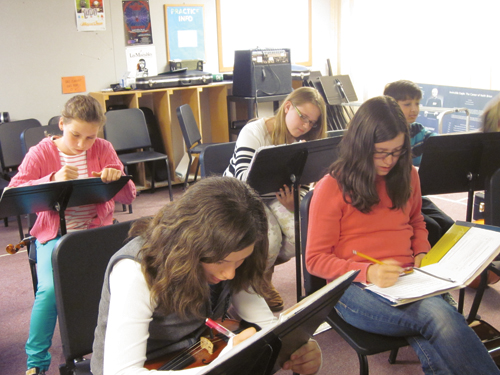
Assessment has become a topic of increasing concern among educators, particularly as education policy makers place a stronger emphasis on teacher and student accountability. Many states are starting to consider student growth in determining teacher effectiveness. Because most states do not have standardized music assessments, directors have to determine and implement their own evaluations to measure student growth.
However, many music teacher preparation programs do not include courses in this area. Even at the graduate level, such courses are commonly offered only as an elective. Consequently, many music educators feel overwhelmed by the process of assessment. Large class sizes, performance expectations, and limited instructional time add to the challenge of evaluating band and orchestra students.
Fortunately, implementing an effective system is easier than it may seem. With clear goals, a structured plan, and a consistent approach, assessing students in an ensemble can become a regular part of the class.
Initial Evaluations
Diagnostic assessments are not just for math and language arts. At the beginning of the school year, administer both a performance-based and a written assessment to discover students’ strengths and weaknesses across various aspects of music. This will help shape the focus for the year. For example, if students already have a firm grasp of staccato articulations but struggle with understanding minor scales, adapt curricular goals to best address this area.
Diagnostic assessments are also invaluable in determining student growth over the course of the school year. When teachers can compare diagnostic test results with assessments at the end of a unit or year, they quickly see which instructional elements worked and which were unsuccessful.
A final use for diagnostic evaluations at the start of the year is to determine what knowledge and skills were lost over summer break. Use this information to refine teaching methods for the future.
Appropriate material for this evaluation may include etudes or exercises from the previous year. Often, method books have corresponding written assessments that can be used to determine retention of music theory concepts. Look for resources that will accurately reflect students’ knowledge.
Identify Goals
Once you have determined a starting point, look to the school, district, or state curriculum to see where your students’ levels fit into the bigger picture. Plan the curriculum to meet clear, attainable, and measurable goals.
When determining goals for the year, make sure they are specific. Students will play in quartets is not sufficient. Instead, create a clearer goal, such as, students will accurately perform independent musical lines in a four-part chamber ensemble. This level of specificity clearly defines expectations, and helps both teachers and students focus their efforts on the targeted material.
Ensure the goals are attainable. While a teacher may have high ambitions for growth throughout the year, remember to consider what was found in the diagnostic assessment, as well as the more informal, daily observations of skills and knowledge. Break down larger performance and content goals into smaller, manageable units. This increases the likelihood of success and often improves overall motivation as students notice their progress.
Finally, make sure goals are measurable. Keep in mind that knowledge-based skills can be more easily measured (through a written quiz, for example) than performance goals. Perhaps one goal is for students to improve overall tone quality throughout the year. Have a clear idea of how to consistently evaluate and measure that skill.
Appropriate Assessments
In performance-based classrooms, the majority of students’ time is typically spent playing instruments. As such, many band and orchestra teachers will find that performance-based assessments comprise the majority of their testing approach. The example below shows a detailed method to evaluate a particular performance skill.
Articulation
Student rarely performs the indicated articulations, missing eight or more
Student performs some of the indicated articulations, missing six or seven
Student performs many indicated articulations, missing four or five
Student performs most indicated articulations, missing two or three
Student consistently performs all indicated articulations, missing one or fewer
Written or online quizzes may work better for testing music theory knowledge. Be creative. Students could write program notes for an upcoming performance to demonstrate an understanding of historical and cultural events related to the music. A year-long portfolio allows the teacher to observe a student’s overall growth throughout the year. Take the time to find appropriate ways to assess students’ skills.
.jpg)
A variety of assessment methods offers teachers a more comprehensive perspective on student knowledge and allows them to identify and target any critical gaps. A student who has a difficult time performing a major scale, may perfectly understand the theory behind the scale. Another student may be able to correctly perform a rhythm, but cannot identify and label the counts on paper.
Develop a Reasonable Plan
After the goals and a plan to assess progress are determined, create a calendar outlining when and how to incorporate those elements into the school year. Decide at what points students should achieve certain skills. Performance repertoire should complement these plans. When developing a year-long plan, keep in mind existing obligations. If there is an important ensemble performance in March, consider strategically planning student assessments around the performance date to maximize critical ensemble rehearsal time. For example, an individual playing test two weeks prior to the performance helps ensure that students master their parts before the last minute. A written assessment addressing cultural elements of a recent program could be administered following the performance.
Keep in mind that the time required goes beyond the class time used to administer a test or worksheet. The ten minutes spent every Friday for a brief quiz does not include the time spent outside of class grading those quizzes. Many directors have hundreds of students, so it is important to be practical and strategic when planning assessments throughout the year. Plans that are too ambitious or time consuming run the risk of being abandoned when things get busy.
Keep Records, Give Feedback,
Be meticulous about entering assessment results into a database that is clear and easy to interpret, and remember to back up that file. Keeping track of progress is critical to improving not only student knowledge, but also your teaching strategies. It also serves as a record of your effectiveness as a teacher.
Regular assessment yields many opportunities to give students clear and specific feedback. Embrace these opportunities to ensure students are aware of their successes and areas for improvement. For performance-based assessments, include specific strategies for potential improvement. For written assessments, cite resources that might help students struggling with certain content. The more clear and specific the feedback, the greater the chance a student will take away something valuable.
Finally, once you create a plan for the year, stick with it. It is not enough to simply plan to assess; you must execute that plan for it to yield valuable information about students’ growth and your effectiveness. Busy schedules and the drive to produce outstanding concert performances often lead to a failure to follow even the most well-intentioned plans. Consistency and commitment to the plan are essential to accurately assess students and make improvements to your teaching methods. By maintaining clear goals and adhering to a plan, even large ensemble directors can effectively assess and evaluate music students.






